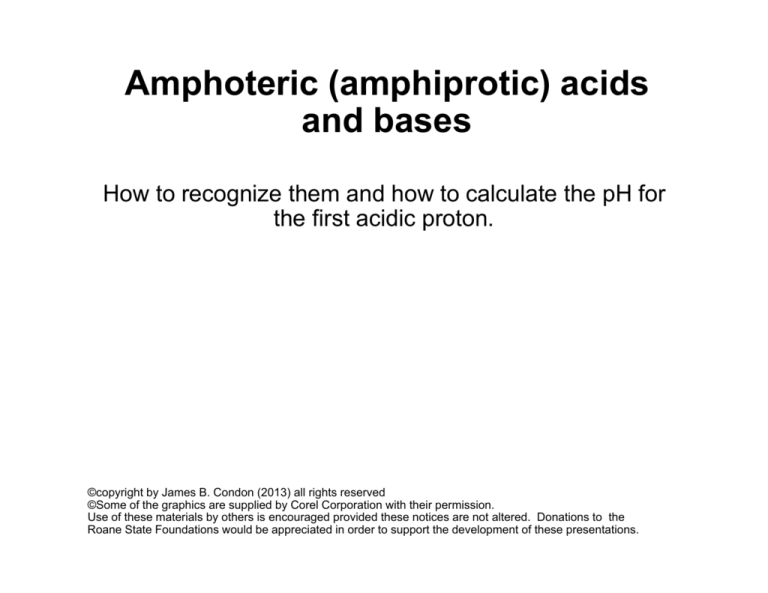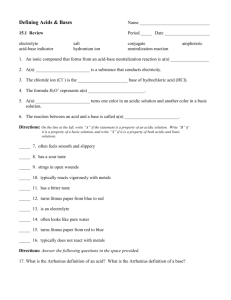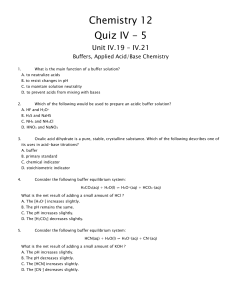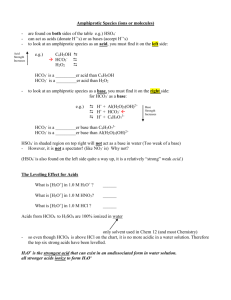
Amphoteric (amphiprotic) acids
and bases
How to recognize them and how to calculate the pH for
the first acidic proton.
©copyright by James B. Condon (2013) all rights reserved
©Some of the graphics are supplied by Corel Corporation with their permission.
Use of these materials by others is encouraged provided these notices are not altered. Donations to the
Roane State Foundations would be appreciated in order to support the development of these presentations.
Amphiprotic acids
Many acids have more that one acidic proton. The following
are some examples:
H2SO4 + H2O º H3O+ + HSO4!
HSO4! + H2O º H3O+ + SO42!
K1 = very large
K2 = 2.0 × 10-2
H2SO3 + H2O º H3O+ + HSO3!
HSO3! + H2O º H3O+ + SO32!
K1 = 1.7 × 10–2
K2 = 6.24 × 10–8
H3PO4 + H2O º H3O+ + H2PO4!
H2PO4! + H2O º H3O+ + HPO42!
HPO4! + H2O º H3O+ + PO43!
K1 = 1.1 × 10–2
K2 = 7.5 × 10–8
K3 = 4.8 × 10–12
H2CO3 + H2O º H3O+ + HCO3!
HCO3! + H2O º H3O+ + CO32!
K1 = 4.31 × 10–7
K2 = 4.4 × 10–11
Each proton has its own Ka . These are designated “K1", “K2"...
Amphiprotic acids
Notice if one were to classify some of the ions, they could
qualify as both an acid and a base.
For example in the reactions:
H2SO4 + H2O º H3O+ + HSO4!
acid 1
base 1
acid 2
base 2
HSO4! + H2O º H3O+ + SO42!
acid 1
base 1
acid 2
base 2
HSO4! is a base in the first reaction and an acid in the
second one.
Amphiprotic acids
Notice if one were to classify some of the ions, they could
qualify as both an acid and a base.
Likewise for the others:
H2SO3 + H2O º H3O+ + HSO3! HSO3! is a base
acid 1
base 1
acid 2
base 2
HSO3! + H2O º H3O+ + SO32!
acid 1
base 1
acid 2
base 2
HSO3! is an acid
Amphiprotic acids
Notice if one were to classify some of the ions, they could
qualify as both an acid and a base.
Likewise for the others:
H3PO4 + H2O º H3O+ + H2PO4!
acid 1
base 1
acid 2
base 2
H2PO4! + H2O º H3O+ + HPO42!
acid 1
base 1
acid 2
base 2
HPO4! + H2O º H3O+ + PO43!
acid 1
base 1
acid 2
H2PO4! is a base
base 2
H2PO4! is an acid
HPO42! is a base
HPO42! is an acid
Amphiprotic acids
Notice if one were to classify some of the ions, they could
qualify as both an acid and a base.
Likewise for the others:
H2CO3 + H2O º H3O+ + HCO3! HCO4! is a base
acid 1
base 1
acid 2
base 2
HCO3! + H2O º H3O+ + CO32!
acid 1
base 1
acid 2
base 2
HCO4! is an acid
Amphiprotic acids
The calculations for these polyprotic acids are the same as
others. The only one presented in this slideshow is the pH of
the first proton. For H2SO4 this is easy since the first proton
is strong. For the example H2SO3 is used here.
Amphiprotic acids
The calculations for these polyprotic acids are the same as others. The only one presented
in this slideshow is the pH of the first proton. For H2SO4 this is easy since the first proton is
strong. For the example H2SO3 is used here.
Example: Calculate the pH of a 0.10 M solution of H2SO3.
x
Use the first reaction: H2SO3 + H2O º H3O+ + HSO3!
Create at table for this type II problem:
[H2SO3]
[H3O+]
[HSO3!]
before equilibrium
0.10
0.0
0.0
Write the equilibrium expression:
Solving
(successive
approximations)
2
x
1.3 × 10!2 =
0.10 ! x
after equilibrium
0.10 ! x
x
x
[H3O+][HSO3!]
Ka1 =
[H2SO4]
x = 3.0 × 10!2
pH = 1.52
Amphoteric bases
Bases may also be amphoteric. Here’s an extreme example:
Al(OH)63! + H2O º Al(H2O)(OH)52! + OH!
acid
Al(H2O)(OH)52! + H2O º Al(H2O)2(OH)4! + OH!
base
acid
Al(H2O)2(OH)4!+ H2O º Al(H2O)3(OH)3 + OH!
base
acid
Al(H2O)3(OH)3 + H2O º Al(H2O)4(OH)2+ + OH!
base
acid
Al(H2O)4(OH)2 + H2O º Al(H2O)5(OH)12+ + OH!
base
acid
Al(H2O)5(OH)12 + H2O º Al(H2O)63+ + OH!
base
acid
Amphoteric bases
Bases may also be amphoteric. Here’s an another example
for a weak base:
H2NNH2 + H2O º H2NNH3+ + OH!
base
acid
Kb1 = 1.2 × 10!6
H2NNH3+ + H2O º H3NNH32+ + OH!
base
acid
Kb2 = 8.9 × 10!16
Amphoteric bases
H2NNH2 + H2O º H2NNH3+ + OH!
H2NNH3+ + H2O º H3NNH32+ + OH!
Kb1 = 1.2 × 10!6
Kb2 = 8.9 × 10!16
Example: Calculate the pH of a 0.15 M solution of H2NNH2.
x
H2NNH2 + H2O º H2NNH3+ + OH!
Creating a table for this type II problem.
[H2NNH2]
[OH!]
[H2NNH3+]
before equilibrium
0.15
0.0
0.0
after equilibrium
0.15 ! x
x
x
[OH!][H2NNH3+]
Kb1 =
[H2NNH2]
Write the equilibrium expression:
Substituting and solving:
2
x
x = 4.2 × 10!4 pOH = 3.37, pH = 10.63
1.2 × 10!6 =
0.15 ! x
Amphoteric (amphiprotic) acids
and bases
How to recognize them and how to calculate the pH for
the first acidic proton.
THE END







